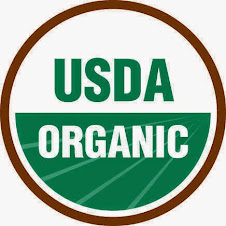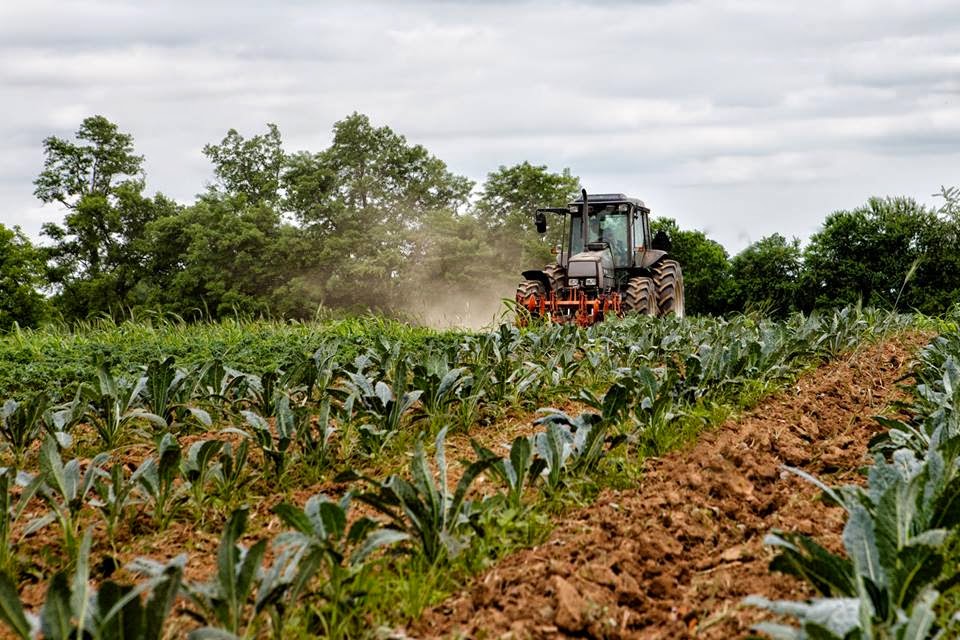Organic farming
systems, like the one employed at Elmwood Stock Farm, are working
environmentally, economically, personally, and in practicality. This week we
will share a few tales of what we are witnessing and how it translates to you
and your food in more ways than one.
At the farmers
market this past weekend, we had several conversations with customers about how
the tomato plants in their gardens had all the leaves turn brown and die, was
it from all the rain? The answer is yes, well sorta. Tomato plants like hot dry
weather with temperatures that stay warm at night. There has been almost none
of that in Central Kentucky this year until now. The conditions in our area so
far this year cause plants to set less fruit, the fruit to have cracking
issues, be smaller, and prone to virus and bacterial diseases. You see this especially if the tomato plants
are growing on bare soil and are grown every year in the same relatively small
area, like a home garden. The plants are being ravaged by a couple of common
fungal diseases known as Early Blight and Late Blight. Volumes have been
written on these diseases, but suffice it to say, the spores are rampant in
this area, especially with the weather pattern we are in. There is not much you
can do other than keep the soil covered in the spring to reduce rain drops from
splattering soil up onto the small plants, and removing the brown leaves as
they show up to reduce sporulation.
Out at the farm,
our tomatoes are not on track for a big crop, but it will not be as bad as a
few years back, when we had a cold wet spring and short summer. Our vines still
have green leafy growth compared to some, though plant thriftiness is also
variety specific. The long-term soil
building and feeding of the soil food web must be at play in providing a strong
immune system for the plants. Because
of this, along with other techniques specific to growing tomatoes organically,
our crop is performing better than the last time the weather conditions were
like this season. Certain varieties resist plant disease better than others,
and the tomato crop will not be as plentiful as some years, but we have not
been wiped out yet. Please keep in mind that the commercial tomato production
guides recommend that toxic fungicides be sprayed every 7-10 days, and possibly
more often during wet weather patterns. These are best applied using an
emulsified misting, sprayed to essentially cover all upper and lower leaf
surfaces with the chemical, and obviously a swath all around the area adjacent
to the plants. The applicator is advised to wear protective coveralls, goggles,
and full respirator. There will be a ‘no harvest’ time interval that varies
depending on the degree of residual control for that chemical compound. And to
hear other growers talk, it is still not working very well. At Elmwood Stock
Farm, we don’t own one of those sprayers, or chemical suits and accessories. We
do not have to pay big bucks to purchase the chemicals. We do not have these
toxins poisoning the thousands of species of beneficial fungi that help our
plants thrive. We do not have to take the time to mix, spray, and clean up the
equipment. We do not have to wait to harvest the fruit when ripe. We do not
have to tell our workers and children to stay away for any reason. We do not
have to try to explain to our customers why the use of these chemicals is
normal and a good thing.
the problem for
us and for the cattle. Today we do not
have to buy the super-duper pesticide, or crowd the animals up just to get a
spot on each one (or on us from spillage).
Given the opportunity, natural systems will reappear and will work.
Sometimes it is
easy to see the environmental, economic, personal, and practical benefits of an
organic farming system, when you employ it long enough to benefit from its
natural cycle. Thanks for letting us
share a few examples of how Mother Nature is able to take care of her own, when
we keep toxic chemicals out of our environment and our food.
In Your Share
Green Beans – organic
Blackberries or
Raspberries – organic
Sweet Corn – organic
Sweet Onions – organic
Peppers – organic
Potatoes – organic
Tomatoes – organic
Swiss Chard – organic
EggplantRecipes to Enjoy
Italian Method
Ratatouille, a Janine
Washle recipe in Kentucky Monthly. Keeping each vegetable in its own section is
an old, Italian method for preparing ratatouille. Each vegetable cooks within itself and retains its essence before
being combined. The end result is a
mixture that retains the unique texture and taste of each vegetable.
¼
C olive oil, plus more as needed
1
½ C onion, chopped
4
garlic cloves, minced
2
C eggplant, chopped with skin on
2
C peppers, chopped – bell, hot, whatever you want
1
C zucchini, chopped
1
C yellow squash, chopped
2
C tomatoes, seeded and chopped
1
T fresh basil leaves, thinly sliced
1
T parsley, chopped
1
tsp thyme or oregano, chopped
salt
and pepper
Preheat oven to 400°F. Set a large sauté pan over medium heat and add olive oil. Add onions and garlic, cooking until onions
are translucent. Spread onions and
garlic on a large baking sheet.
Add the eggplant to the sauté pan and cook for
about 5 minutes or until partially cooked.
Layer eggplant over the top of one-fourth of the onion mixture.
Add the peppers to the sauté pan and cook until
soft, about 5 minutes. Layer a
one-fourth section of peppers beside the eggplant.
Add zucchini and yellow squash to the sauté pan
and cook until partially cooked, about 5 minutes. Layer a section beside the peppers.
Add tomatoes and cook until juices are
released. Make a section for them.
Sprinkle the herbs over the top of all sections
of vegetables. Place in the oven and
roast for 20 minutes. Remove from oven
and refrigerate for up to a week.
Green Bean Pate, this has
proved to be a popular dish!
½ lb fresh green
beans, trimmed
1 T oil
1 onion,
coarsely chopped
3 hard boiled
eggs
3 T finely
chopped basil
1 tsp lemon rind
mayonnaise
seasoned salt
and pepper
Cook beans until
tender by boiling or steaming them. Drain.
In skillet, heat
oil. Add onion and sauté until
softened. Cool.
In a food
processor grind green beans, onions, eggs, basil and lemon rind until roughly
pureed. Remove from bowl and add enough
mayo to hold mixture together. Stir in
salt and pepper to taste. Chill. Serve with Melba toast or crackers.
Moroccan
Eggplant and Pasta
1 T + 1 T olive oil
1 lb eggplant, cut into ½-inch cubes
½ + ¾ tsp salt
1 lb ground beef
½ C chopped onion
1 tsp minced garlic
1 tsp cumin
½ tsp crushed red pepper
1/8 tsp cinnamon
3 C chopped tomatoes
½ C chicken broth
1 T lemon juice
¼ C chopped fresh mint
corkscrew pasta
Prepare pasta
according to package directions.
Heat 1 T olive
oil in skillet over medium-high heat.
Add eggplant and ½ tsp salt.
Cook stirring, until tender and just brown, 10 minutes. Transfer eggplant to bowl.
Add 1 T oil to
skillet. Add ground beef, onion, and ¾
tsp salt. Cook until well browned. Drain fat from skillet. Add garlic, cumin, red pepper, and cinnamon
and cook 1 minute.
Stir in eggplant, tomatoes, chicken broth,
and lemon juice. Bring to a boil. Reduce heat, cover, and simmer 5
minutes. Stir in fresh mint. Toss with pasta and serve.




